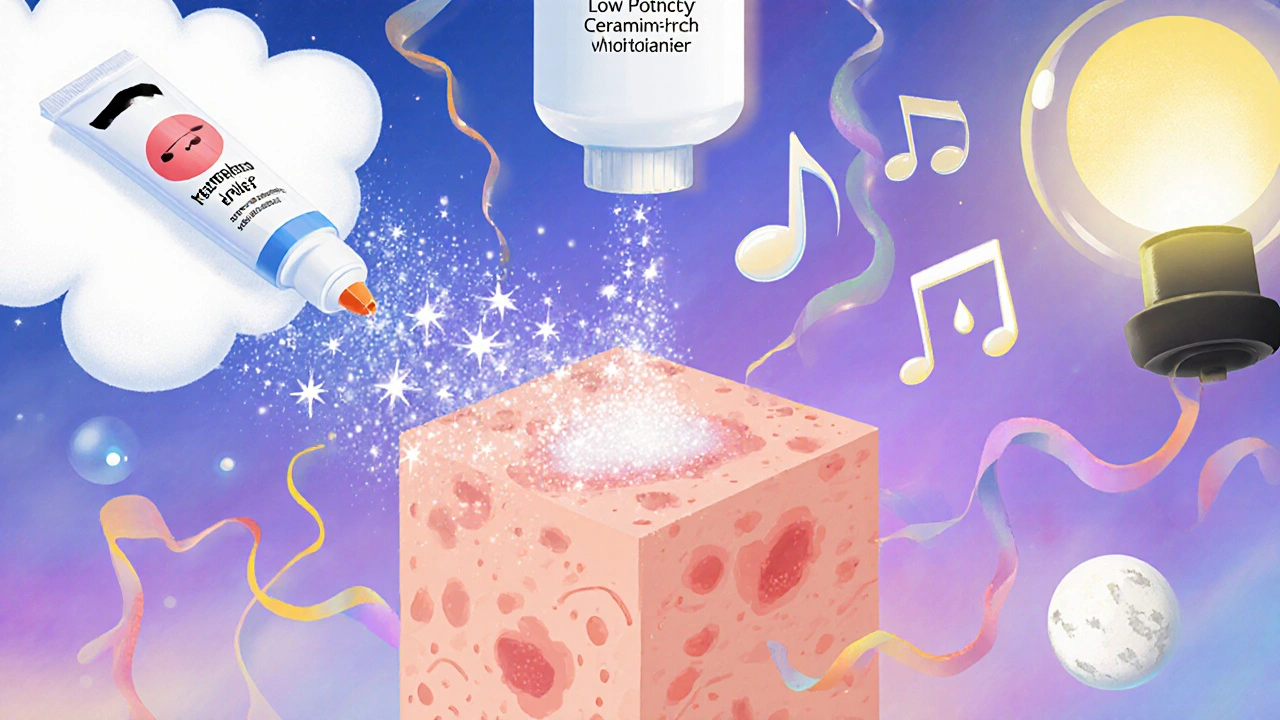
When treating chronic skin conditions, Pimecrolimus is a topical calcineurin inhibitor that reduces inflammation by inhibiting T‑cell activation. While it works well on its own, many clinicians pair it with other agents to tackle stubborn flares, improve skin barrier function, and cut down steroid exposure. This guide walks through why and how you might combine pimecrolimus with other treatments, what evidence says, and practical tips for safe use.
How Pimecrolimus Works
At its core, pimecrolimus blocks the enzyme calcineurin, halting the cascade that leads to cytokine release and itchy inflammation. By staying on the skin surface, it avoids the systemic side effects seen with oral immunosuppressants. Unlike traditional steroids, it doesn’t cause skin thinning, making it a favorite for sensitive areas like the face and flexures.
Why Combine Therapies?
Monotherapy often falls short when the disease is widespread, deep‑seated, or when patients have built tolerance to a single approach. Combination therapy can:
- Accelerate symptom control.
- Limit the potency or duration of each individual drug, reducing side‑effects.
- Address multiple disease pathways-immune modulation, barrier repair, and itching.
Choosing the right partners hinges on the specific skin condition and the patient’s needs.
Key Skin Conditions Treated with Pimecrolimus
The most common indications include:
- Atopic dermatitis (eczema) - especially on the face, neck, and skin folds.
- Psoriasis - limited‑area plaque types when steroids are undesirable.
Both conditions involve an overactive immune response, making pimecrolimus a logical anchor for combination regimens.

Common Combination Partners
Below are the most frequently paired agents and why they complement pimecrolimus.
| Combination | Primary Indication | Typical Regimen | Benefits | Key Considerations |
|---|---|---|---|---|
| Pimecrolimus + Low‑Potency Corticosteroids | Acute eczema flare | Apply steroid once daily for 3‑5 days, then switch to pimecrolimus twice daily. | Rapid itch relief, then maintenance without steroid side‑effects. | Monitor for skin atrophy in long‑term steroid use. |
| Pimecrolimus + Moisturizers | Chronic eczema | Moisturizer morning & night; pimecrolimus twice daily on affected patches. | Improves barrier function, reduces need for higher‑dose pimecrolimus. | Select fragrance‑free, ceramide‑rich creams for best barrier support. |
| Pimecrolimus + Calcineurin inhibitors (Tacrolimus) | Severe or extensive atopic dermatitis | Alternate nights: tacrolimus 0.1% ointment, then pimecrolimus 1% cream. | Targets different skin depths, limiting resistance. | Watch for local burning; educate patients about transient sensations. |
| Pimecrolimus + Phototherapy | Plaque psoriasis, especially on elbows/knees | NB‑UVB three times weekly; apply pimecrolimus on off‑therapy days. | Synergistic reduction in plaque thickness; lower cumulative UV dose. | Ensure sunscreen use; avoid over‑exposure. |
| Pimecrolimus + Antihistamines | Pruritic eczema with nocturnal itch | Oral second‑generation antihistamine nightly; pimecrolimus twice daily. | Improves sleep, reduces scratching‑induced damage. | Check for drowsiness; choose non‑sedating options if daytime dosing. |
| Pimecrolimus + Barrier repair agents | Very dry, fissured skin | Apply ceramide‑enriched barrier cream after pimecrolimus. | Restores lipid matrix, prolongs anti‑inflammatory effect. | Apply on clean, slightly damp skin for optimal absorption. |
Practical Tips for Clinicians
- Start with a short trial of low‑potency steroids for severe flares, then transition to pimecrolimus for maintenance.
- Educate patients that a mild burning sensation with pimecrolimus is common and usually subsides within a week.
- Choose fragrance‑free moisturizers that contain ceramides, cholesterol, and free fatty acids.
- When combining with phototherapy, schedule the light session at least two hours after applying pimecrolimus to avoid photosensitivity confusion.
- Document any concurrent systemic immunosuppressants; avoid duplicative calcineurin inhibition unless closely monitored.

Safety, Monitoring, and Contraindications
Pimecrolimus is generally well‑tolerated, but keep an eye on:
- Local irritation - advise patients to use a bland moisturizer if needed.
- Rare reports of skin infections - counsel on proper hygiene.
- Pregnancy and lactation - data are limited; discuss risk‑benefit with the patient.
Contraindications include known hypersensitivity to pimecrolimus or any of its excipients. For patients with compromised barrier function (e.g., active dermatitis herpetiformis), consider alternative approaches.
Patient Perspective: Real‑World Experiences
Emma, a 28‑year‑old with facial eczema, tried a steroid cream for months but noticed thinning skin. Switching to pimecrolimus twice daily, along with a ceramide moisturizer, gave her clear skin within three weeks and no further thinning. She reports a slight tingling in the first few days, but says it’s worth the trade‑off.
Mark, a 45‑year‑old with plaque psoriasis on his knees, paired weekly NB‑UVB with pimecrolimus on off‑days. After two months his plaques softened and required fewer UV sessions, saving him time and reducing cumulative UV exposure.
Frequently Asked Questions
Can I use pimecrolimus and a steroid at the same time?
Short‑term overlap is safe for severe flares, but most guidelines recommend a brief steroid burst followed by pimecrolimus for maintenance to avoid skin thinning.
Is pimecrolimus suitable for children?
Yes, it’s approved for children over 2 years old with atopic dermatitis, especially on delicate areas where steroids are risky.
How long does it take to see results?
Most patients notice reduced itching within 3‑5 days; visible clearance of lesions may take 2‑4 weeks of consistent use.
Can I combine pimecrolimus with oral antihistamines?
Yes, oral antihistamines can help control nocturnal itching and improve sleep, complementing the topical anti‑inflammatory effect.
What should I do if I experience a burning sensation?
Apply a soothing, fragrance‑free moisturizer after the medication. If irritation persists beyond a week, contact your clinician for possible regimen adjustment.
Understanding how pimecrolimus fits into a broader therapeutic plan can boost outcomes for patients struggling with stubborn eczema or psoriasis. By pairing it wisely with steroids, moisturizers, phototherapy, or antihistamines, clinicians can target multiple disease pathways while keeping side‑effects low.






5 Comments
I totally get the frustration of dealing with stubborn eczema – it’s like an unwanted roommate that never pays rent. Friendly reminder: you don’t have to suffer in silence, there are smarter combos out there. Pairing pimecrolimus with a gentle moisturizer can calm the burning and keep the barrier happy. Just remember, a little patience goes a long way.
/p>Oh man, the drama of trying to tame a flare can feel like starring in a never‑ending soap opera, and when you finally think you’ve found the perfect routine, the universe throws another itch your way. First, you slap on a low‑potency steroid for a quick fix, hoping the relief will be instant, but the skin still feels like it’s being sandblasted. Then you hear about pimecrolimus, the “nice guy” of topical agents, promising calm without the dreaded thinning, and you’re like, why not give it a whirl? You start with the steroid burst, watch the redness dip for a few days, and then gracefully transition to pimecrolimus twice daily, feeling like you’ve finally graduated from the school of hard knocks. The next step? Adding a ceramide‑rich moisturizer, because who doesn’t love that silky barrier‑boosting feeling? Your nights become less about scratching until you’re a human pretzel and more about actual sleep, especially if you toss in an evening antihistamine. Meanwhile, the dermatologist nods approvingly, noting that your regimen now hits two pathways: immune modulation and barrier repair. You even experiment with phototherapy on off‑days, and the plates start to align – fewer UV sessions, softer plaques, and a sigh of relief that feels like a standing ovation. The only hiccup is the occasional mild burning when you first apply pimecrolimus, but that fades like the closing credits after a tense episode. Over a month, the skin looks clearer, the itching subsides, and you start to believe that maybe, just maybe, you’ve tamed the beast. The lesson? Consistency and a well‑planned combo can turn a chaotic flare into a manageable storyline, and you can finally stop playing the role of the perpetual victim. So if you’re on the edge of giving up, remember that the right partnership of meds can rewrite the script entirely, giving you back the confidence to step out without hiding behind long‑sleeved shirts. Keep your head up, stay the course, and watch the drama dissolve into a calm, steady peace. When the skin finally settles, you’ll notice that the fear of future flares diminishes, replaced by a quiet confidence that you can handle whatever comes next. Trust the process, and let the combination therapy be your backstage crew, handling the messy parts while you shine.
/p>A balanced regimen with pimecrolimus, barrier creams, and occasional low‑potency steroids can give steady control without compromising skin integrity.
/p>Honestly, if you’re still slapping greasy steroids on delicate facial skin, you’re basically signing up for premature aging and unnecessary thinning. It’s high time to own up to the fact that pimecrolimus is the decent, responsible choice that respects the skin’s natural barrier. Mixing it with fragrance‑free moisturizers isn’t just a nice‑to‑have; it’s a moral imperative if you care about long‑term health. Stop treating your skin like a sacrificial lamb and give it the gentle partnership it deserves.
/p>One could argue that the skin is a canvas upon which our internal tensions manifest, and by choosing pimecrolimus we paint with softer strokes rather than harsh erasures 🙂. When the immune system overreacts, the calm we seek is a balance between suppression and support, a dialectic that mirrors life itself.
/p>